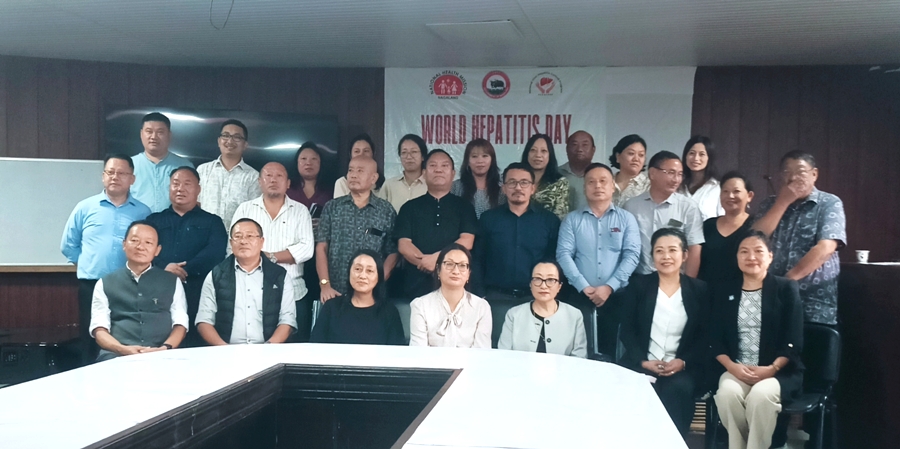Dimapur has the highest prevalence of hepatitis B and C in Nagaland, including cases among pregnant women, according to National Health Mission Nagaland.
Share

KOHIMA — Dimapur has reported the highest prevalence of hepatitis B and C in Nagaland, including hepatitis B among pregnant women, according to Dr. Avile Zao, Mission Director of National Health Mission (NHM) Nagaland. She attributed this trend to Dimapur’s diverse and cosmopolitan population.
Speaking at the World Hepatitis Day 2025 event on Monday at the Directorate of Health and Family Welfare, Kohima, Dr. Zao presented the latest statistics for 2024–25: hepatitis B prevalence stands at 2.4%, hepatitis C at 4.01%, and hepatitis B among pregnant women at 0.8%.
She informed that screening services for hepatitis B and C are available at all government hospitals and health and wellness centres. Free viral load testing and treatment for both infections are provided at all district hospitals.
Additionally, hepatitis B immunoglobulin is supplied free of charge to infants born to hepatitis B-positive mothers under the National Viral Hepatitis Control Programme (NVHCP).
All pregnant women, she reminded, should be tested for hepatitis B during antenatal care (ANC), and hepatitis B vaccines are available at no cost through the routine immunization programme for infants.
Breaking barriers and stigma
Marking the significance of the day, Dr. Zao called for breaking the silence and stigma associated with the disease. “Hepatitis affects millions globally, yet many remain unaware of its dangers, transmission modes, and treatments,” she said.
She explained that hepatitis is an inflammation of the liver, most often caused by viruses, though it can also result from toxins, autoimmune disorders, and alcohol or drug use. There are five primary types of viral hepatitis—A, B, C, D, and E—each with different transmission methods.
Hepatitis A and E are generally spread through contaminated food or water, while B and C are transmitted via infected blood and bodily fluids. Hepatitis D only occurs in those already infected with hepatitis B.
Dr. Zao also spoke about non-viral hepatitis, including autoimmune hepatitis, alcoholic hepatitis, and drug-induced hepatitis. Acute hepatitis symptoms include fever, fatigue, loss of appetite, nausea, vomiting, abdominal pain, dark urine, and jaundice.
Chronic hepatitis may be asymptomatic for years but can lead to cirrhosis or liver cancer in advanced stages.
WATCH MORE:
She stressed prevention measures such as safe sex, avoiding shared needles, practicing good hygiene, and ensuring food safety. Vaccines for hepatitis A and B are widely available and effective.
While global in scale, Dr. Zao underscored that action against hepatitis must begin locally. “Let’s break barriers and build a healthier future together,” she urged.
Call to action
Delivering the keynote address, Dr. Mereninla Senlem, Principal Director of Health and Family Welfare, highlighted that World Hepatitis Day, observed annually on July 28, honours Dr. Baruch Blumberg, who discovered the hepatitis B virus and developed its vaccine.
She reiterated the day’s purpose: to raise awareness of viral hepatitis, which causes severe liver diseases and cancer. This year’s theme, “Hepatitis: Let’s Break It Down,” encourages simplifying services and dismantling barriers—financial, social, and systemic—to make prevention, testing, and treatment more accessible.
Citing global data from the WHO, she noted that 304 million people live with chronic hepatitis B or C, and 1.3 million died of hepatitis-related causes in 2022.
Despite effective treatments and vaccines, only 45% of newborns receive the hepatitis B vaccine within 24 hours of birth.
Dr. Senlem reflected on personal and community losses due to hepatitis-related liver cancer and cirrhosis, highlighting the preventable nature of such outcomes. “We have the tools—what we need now is awareness, access, and action,” she said.
Nagaland implemented the National Viral Hepatitis Control Programme in 2019 under the NHM, aligning with India’s goal to eliminate hepatitis as a public health threat by 2030 in line with the Sustainable Development Goals.
She called for expanded access, integrated care, and stronger outreach to meet this goal.
Dr. M. Nukshisangla Jamir, State Nodal Officer of the NVHCP, led the programme and urged the public to utilize available services and help spread awareness. “Ending hepatitis starts with each of us taking responsibility,” she said.
As part of the event, hepatitis B vaccinations were administered to healthcare workers at the Directorate of Health and Family Welfare.